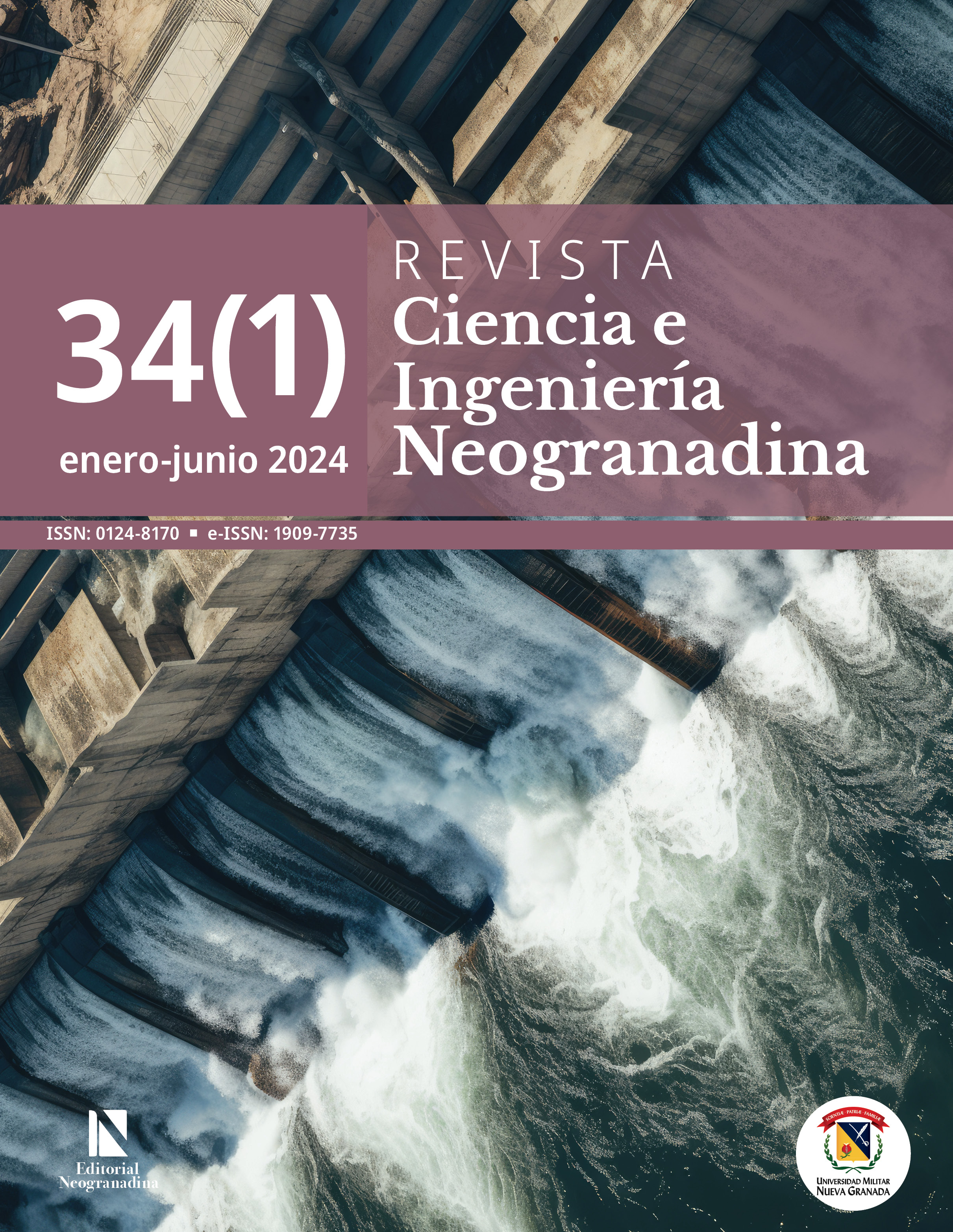Armoring Processes in a Regulated Tropical River: La Miel River Case
Abstract
This study analyzes the armoring process that occurs in the La Miel River (Colombia), an important tropical river that is regulated and strongly modified in its hydrological, hydraulic, and sedimentological regimes. Three different approaches were used to confirm the armoring hypothesis: 1) qualitative verification of the armoring process carried out during a field trip. 2) quantitative verification of armoring using the criteria defined by Little y Meyer (1976) for the geometric standard deviation of the granulometry of the bed (determined with the BASEGRAIN software). and 3) analysis of the records of suspended and bed sediment load in the hydrosedimentological monitoring stations. The results indicate that La Miel river is armor according to field evidence and the marked decrease in the bed sediment load In addition, it is identified that the armoring process has occurred on shorter time scales than those reported in the literature for extratropical rivers due to excess transport capacity caused by the systematic increase in minimum flows after the regulation and transfer of the Guarinó and Manso rivers. On the other hand, we can indicate that there is a significant flow threshold (234 m3/s) which must be exceeded to break the armor layer and for bed load transport to be present.
Downloads
References
E. D. Andrews y G. Parker, “Formation of a course surface layer as the response to gravel mobility”, in Sediment Transport in Gravel-Bed Rivers, pp. 269-325, 1987.
G. Parker, “Transport of Gravel and Sediment Mix- tures”, in Sedimentation Engineering, American So- ciety of Civil Engineers, pp. 165-251, 2008. https://doi:10.1061/9780784408148.ch03.
W. C. Little y G. P. Meyer, “Stability of Channel Beds by Armoring”, Journal of the Hydraulics Division, vol. 102, no. 11, pp. 1647-1661, Nov., 1976. https://doi:10.1061/JYCEAJ.0004651.
G. Parker y P. C. Klingeman, “On why gravel bed streams are paved”, Water Resour Res, vol. 18, no. 5, pp. 1409-1423, Oct., 1982. https://doi.org/10.1029/ WR018i005p01409.
G. Parker, C. P. Klingeman y G. D. McLean, “Bedload and Size Distribution in Paved Gravel-Bed Streams”, Journal of the Hydraulics Division, vol. 108, no. 4, pp. 544-571, Apr., 1982. https://doi.org/10.1061/JYCEAJ.0005854.
M. A. Hassan y M. Church, “Experiments on surface structure and partial sediment transport on a gravel bed”, Water Resour Res, vol. 36, no. 7, pp. 1885-1895, Jul., 2000. https://doi.org/10.1029/2000WR900055.
K. G. Heays, H. Friedrich y B. W. Melville, “Laboratory study of gravel-bed cluster formation and disintegra- tion”, Water Resour Res, vol. 50, no. 3, pp. 2227-2241, Mar., 2014. https://doi.org/10.1002/2013WR014208.
J. P. L. Johnson, “Clustering statistics, roughness feedbacks, and randomness in experimental step- pool morphodynamics,” Geophys Res Lett, vol. 44, no. 8, pp. 3653–3662, Apr. 2017. https://doi.org/10.1002/2016GL072246.
M. Church, M. A. Hassan y J. F. Wolcott, “Stabilizing self-organized structures in gravel-bed stream channels: Field and experimental observations”, Water Resour Res, vol. 34, no. 11, pp. 3169-3179, Nov., 1998. https://doi.org/10.1029/98WR00484.
L. Wittenberg, J. B. Laronne y M. D. Newson, “Bed clusters in humid perennial and Mediterranean ephemeral gravel-bed streams: The effect of clast size and bed material sorting”, J Hydrol (Amst), vol. 334, no. 3, pp. 312-318, 2007. https://doi.org/10.1016/j.jhydrol.2006.09.028.
R. R. Hendrick, L. L. Ely y A. N. Papanicolaou, “The role of hydrologic processes and geomorphology on the morphology and evolution of sediment clusters in gravel-bed rivers”, Geomorphology, vol. 114, no. 3, pp. 483-496, 2010. https://doi.org/10.1016/j.geomorph.2009.07.018.
M. G. Wolman, “A method of sampling coarse river-bed material”, Transactions, vol. 35, no. 6, pp. 951- 956, 1954.
A. Domínguez, “Procesamiento digital de imágenes”, Perfiles Educativos, vol. 72, p. 10, 1996.
P. E. Carbonneau, S. N. Lane y N. E. Bergeron, “Catchment-scale mapping of surface grain size in gravel bed rivers using airborne digital imagery”, Water Resour Res, vol. 40, no. 7, Jul., 2004, https://doi.org/10.1029/2003WR002759.
G. L. Heritage y D. J. Milan, “Terrestrial Laser Scanning of grain roughness in a gravel-bed river”, Geomorphology, vol. 113, no. 1, pp. 4-11, 2009, https://doi.org/10.1016/j.geomorph.2009.03.021.
D. Buscombe, D. M. Rubin y J. A. Warrick, “A universal approximation of grain size from images of noncohesive sediment”, J Geophys Res Earth Surf, vol. 115, no. F2, Jun., 2010. https://doi.org/10.1029/2009JF001477.
D. Vázquez-Tarrío, H. Piégay y R. Menéndez-Duarte, “Textural signatures of sediment supply in gravel-bed rivers: Revisiting the armour ratio”, Earth Sci Rev, vol. 207, p. 103211, 2020, https://doi.org/10.1016/j.earscirev.2020.103211.
L. Li, J. Xia, M. Zhou y S. Deng, “Riverbed armoring and sediment exchange process in a sand–gravel bed reach after the Three Gorges Project operation”, Acta Geophysica, vol. 68, no. 1, pp. 243-252, 2020, https://doi.org/10.1007/s11600-019-00391-2.
H. Fu, Y. Shan y C. Liu, “A model for predicting the grain size distribution of an armor layer under clear water scouring”, J Hydrol (Amst), vol. 623, p. 129842, 2023, https://doi.org/10.1016/j.jhydrol.2023.129842.
Q. Wang, L. Li, X. Li, Y. Wang y R. Nie, “Calculation Model to Predict the Static Armor Layer Size Distribution After the Reconstruction of a Gravel River Bed”, Front Earth Sci (Lausanne), vol. 9, 2021. https://doi.org/10.3389/feart.2021.660216.
S. Zhang, Z. Zhu, J. Peng, L. He y D. Chen, “Laboratory study on the evolution of gravel-bed surfa- ces in bed armoring processes”, J Hydrol (Amst), vol. 597, p. 125751, 2021. https://doi.org/10.1016/j.jhydrol.2020.125751.
C. Ikhsan, A. S. Permana y A. S. Negara, “Armor Layer Uniformity and Thickness in Stationary Conditions with Steady Uniform Flow”, Civil Engineering Journal, vol. 8, no. 6, pp. 1086-099, Jun., 2022, https://doi.org/10.28991/CEJ-2022-08-06-01.
C. Ikhsan, “The Effect of Shear Stress on Armor Layer Thickness Under Steady Uniform Flow”, Civil Engi- neering Journal, vol. 9, no. 11, pp. 2806-2822, Nov., 2023, https://doi.org/10.28991/CEJ-2023-09-11-012.
A. S. Negara, C. Ikhsan, RR. R. Hadiani y Hadima- ni. M. Purwana, “River Mobile Armor Layer Induced by Flood”, Civil Engineering Journal, vol. 9, no. 6, pp. 1356-1370, Jun., 2023. https://doi.org/10.28991/CEJ-2023-09-06-05.
M. Zhou, J. Xia, S. Deng, J. Lu y F. Lin, “Channel adjustments in a gravel-sand bed reach owing to upstream damming”, Glob Planet Change, vol. 170, pp. 213-220, 2018. https://doi.org/10.1016/j.gloplacha.2018.08.014.
D. Vázquez-Tarrío, M. Tal, E. Parrot y H. Piégay, “Can we incorrectly link armouring to damming? A need to promote hypothesis-driven rather than expert-based approaches in fluvial geomorphology”, Geomorphology, vol. 413, Sep., 2022. https://doi.org/10.1016/j.geomorph.2022.108364.
M. García y J. Maza, “Capítulo 8. Inicio de movimiento y acorazamiento”, in Manual de Ingeniería de Ríos, 1996.
Isagen, “Cartilla Central-Hidroeléctrica-Miel-I”, p. 4, 2018.
R. J. Batalla, C. M. Gómez y G. M. Kondolf, “Reservoir-induced hydrological changes in the Ebro River basin (NE Spain)”, J Hydrol (Amst), vol. 290, no. 1, pp. 117-136, 2004. https://doi.org/10.1016/j.jhydrol.2003.12.002.
G. Mathias Kondolf y R. J. Batalla, “Chapter 11 Hydrological effects of dams and water diversions on rivers of Mediterranean-climate regions: examples from California”, in Catchment Dynamics and River Processes, vol. 7, C. García y R. J. B. T. D. in E. S. P. Batalla, Ed., Elsevier, 2005, pp. 197-211. https://doi.org/10.1016/S0928-2025(05)80017-3.
L. Villablanca, R. J. Batalla, G. Piqué y A. Iroumé, “Hydrological effects of large dams in Chilean rivers”, J Hydrol Reg Stud, vol. 41, p. 101060, 2022. https://doi.org/10.1016/j.ejrh.2022.101060.
Gotta SAS, Aforos semestrales de monitoreo sobre los ríos La Miel y Guarinó, 2018.
M. Detert y V. Weitbrecht, “Automatic object detec- tion to analyze the geometry of gravel grains-a free stand-alone tool”, in River Flow, 2012, p. 6.
G. Parker y A. J. Sutherland, “Fluvial armor”, Journal of Hydraulic Research, vol. 28, no. 5, pp. 529-544, Sep., 1990. https://doi.org/10.1080/00221689009499044.

Copyright (c) 2024 Ciencia e Ingenieria Neogranadina

This work is licensed under a Creative Commons Attribution-NonCommercial-NoDerivatives 4.0 International License.











